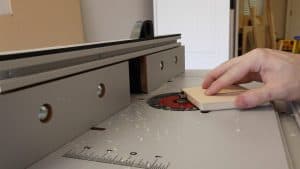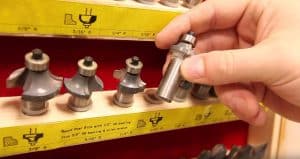Most orders for IN STOCK items placed by 12PM CST M-F ship SAME DAY. Orders for custom items and prints may take additional time to process.
Of course, one the best ways to use a router (at least for certain operations) is to attach the router itself to a router table. This allows the router to stay stationary while you move the material. But did you know a router is one of the most dangerous tools in your shop statistically speaking? Forbes rated the router as #6 on its list of shop tools most likely to be involved in an injury!
In this article, we’re going to focus on router safety as it applies to a router mounted on a router table. See our article on handheld router safety for more tips!
 Tip 1 might sound like a no-brainer, but the truth is it is very commonly ignored. Anytime you are adjusting the router, changing a bit, or otherwise not in the active process of running a router operation, it should be unplugged from the wall. This is honestly a wise tip for any power tool. Turning the switch off is not enough. If you’re struggling to tighten a nut and you grasp the router in the wrong way you could turn it on, likely resulting in serious injury.
Tip 1 might sound like a no-brainer, but the truth is it is very commonly ignored. Anytime you are adjusting the router, changing a bit, or otherwise not in the active process of running a router operation, it should be unplugged from the wall. This is honestly a wise tip for any power tool. Turning the switch off is not enough. If you’re struggling to tighten a nut and you grasp the router in the wrong way you could turn it on, likely resulting in serious injury.
Routers are loud tools. Mine has a rating of 103db. Anything over 85db is considered to be dangerous and could cause long term hearing problems. Its highly recommended you get a good set of high decibel hearing protection and wear them in your shop when running power tools.

And this isn’t just a safety top either. More, smaller passes will result in less burning and less sanding.

| Router Bit Speed Guide | |
| Router Bit Size | Router Speed |
| 1 inch or less | 24,000 RPM |
| 1.25 to 2 inches | 18,000 RPM |
| 2.25 to 2.5 inches | 16,000 RPM |
| 3 to 3.5 inches | 12,000 RPM |

Always move the material against the rotation of the bit (generally from right to left, but not always). Moving with the rotation has a high probability of your material getting thrown free from your control, which could also pull your fingers or hands into the rotation of the bit.
If you have any other router table related safety tips, please feel free to leave them in the comments below. Happy routing!
If you like our content maybe consider upgrading to Premium. You’ll get access to
One Response
0.5